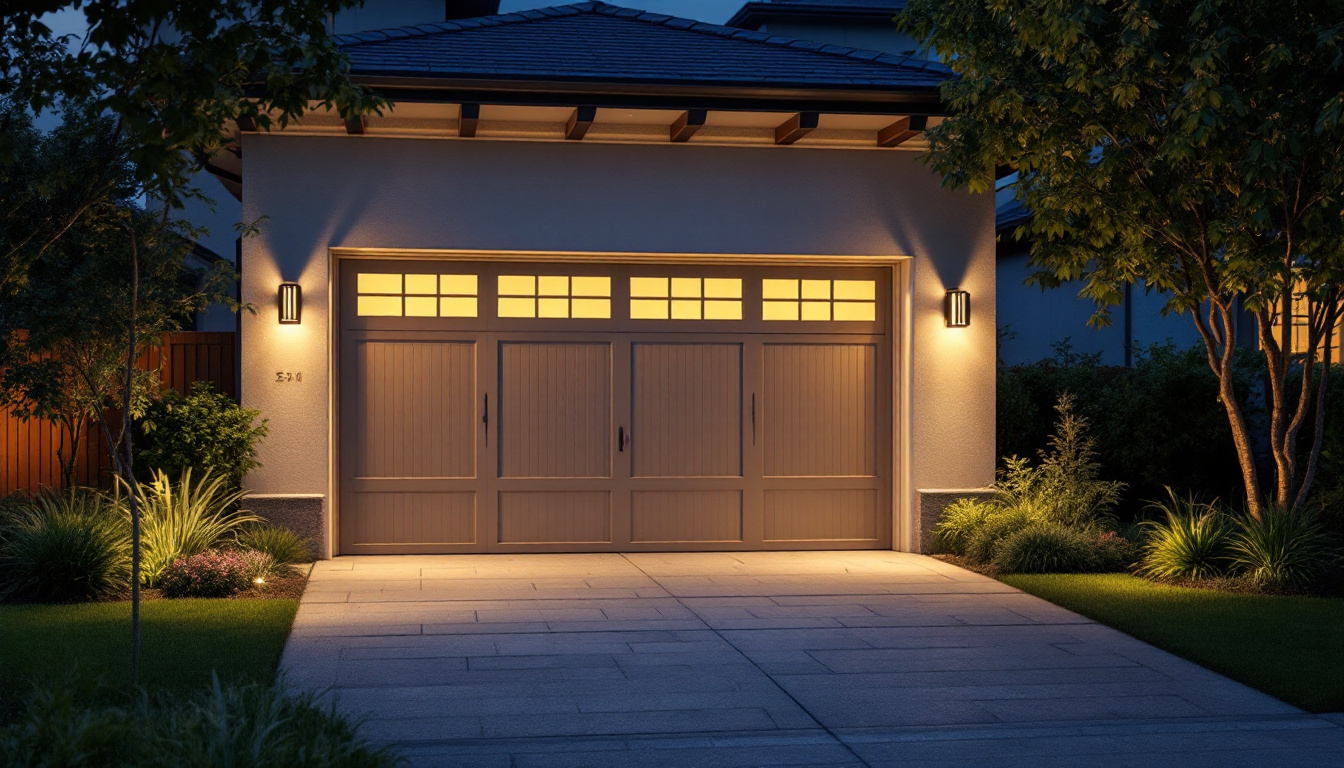
As the demand for outdoor lighting solutions continues to grow, lighting contractors are increasingly called upon to provide innovative and effective designs for residential properties. One of the most critical areas for outdoor lighting is the garage door, where proper illumination not only enhances the aesthetic appeal of a home but also improves safety and security. This article explores best practices for lighting contractors when installing lights outside garage doors, providing insights into design considerations, fixture selection, and installation techniques.
Garage door lighting serves multiple purposes, from enhancing curb appeal to ensuring safety during nighttime hours. Understanding these functions is essential for any lighting contractor aiming to deliver high-quality installations.
One of the primary reasons homeowners invest in garage door lighting is to boost safety and security. Well-lit areas deter potential intruders and reduce the risk of accidents caused by poor visibility. Lighting contractors should recommend fixtures that provide adequate illumination without creating harsh shadows or overly bright spots, which can be disorienting.
motion-sensor lights are particularly effective in this regard, as they only activate when movement is detected, conserving energy while providing illumination when needed. This feature not only enhances security but also provides convenience for homeowners arriving home at night. Additionally, integrating smart lighting systems can allow homeowners to control their garage lights remotely, adding another layer of security by enabling them to turn lights on or off from their smartphones, even when they are away from home.
Beyond safety, lighting around the garage door can significantly enhance the overall look of a property. Thoughtfully designed lighting can highlight architectural features, create inviting pathways, and add a touch of elegance to the home’s exterior. Contractors should consider the style of the home and the surrounding landscape when recommending lighting solutions.
For instance, modern homes may benefit from sleek, minimalist fixtures, while traditional homes might look better with classic lantern-style lights. The right choice can transform a mundane garage door into a focal point of the property. Furthermore, the use of LED lights not only provides energy efficiency but also allows for a variety of color temperatures, enabling homeowners to choose warm or cool lighting that best complements their home’s exterior. This flexibility can enhance the ambiance during evening gatherings or family activities, making the garage area a more inviting space.
When designing a lighting scheme for garage doors, several factors must be considered to ensure functionality and aesthetics align with the homeowner’s preferences.
Proper placement of lighting fixtures is crucial for achieving optimal illumination. Lights should be positioned to avoid glare while ensuring that the entire area around the garage door is well-lit. Typically, fixtures are installed on either side of the garage door, at a height that allows for even light distribution without causing discomfort to the eyes.
In addition to side-mounted fixtures, overhead lighting can also be beneficial. A well-placed ceiling fixture or pendant light can provide additional illumination, particularly for larger garages or those with higher ceilings. Contractors should assess the specific needs of each installation to determine the best placement for maximum effectiveness. Moreover, incorporating motion sensors can enhance safety and convenience, automatically activating lights when someone approaches the garage, which is particularly useful during nighttime or in low-visibility conditions.
The selection of lighting fixtures is another critical aspect of the design process. Contractors should consider various types of fixtures, including wall sconces, floodlights, and decorative lanterns. Each type offers unique benefits and can be tailored to fit the homeowner’s style and functional needs.
Energy efficiency is also a significant consideration. LED fixtures are an excellent choice for outdoor lighting due to their longevity and low energy consumption. Contractors should educate homeowners on the benefits of LED technology, including reduced maintenance costs and environmental impact. Additionally, the aesthetic appeal of fixtures should not be overlooked; choosing designs that complement the architectural style of the home can enhance curb appeal. For instance, vintage-style lanterns may suit a traditional home, while sleek, modern fixtures may be more appropriate for contemporary designs. Homeowners should also consider the color temperature of the lights, as warmer tones can create a welcoming atmosphere, while cooler tones can provide a more modern, crisp look.
Once the design has been finalized, the installation process begins. Proper installation techniques are essential to ensure that the lighting functions as intended and meets safety standards.
Electrical work is a critical component of outdoor lighting installation. Contractors must ensure that all wiring is weatherproof and meets local electrical codes. Using outdoor-rated cables and fixtures is essential to prevent damage from moisture and temperature fluctuations.
Additionally, contractors should consider the use of timers or smart home integration for added convenience. Timers can automatically turn lights on and off at designated times, while smart systems allow homeowners to control their lighting from a mobile device, enhancing usability and energy efficiency. This integration not only streamlines the operation of outdoor lighting but also provides homeowners with the ability to customize their lighting settings based on personal preferences or seasonal changes, further optimizing energy consumption.
After installation, thorough testing is necessary to ensure that all fixtures are functioning correctly. Contractors should check for proper illumination levels, adjust angles as needed, and confirm that motion sensors are calibrated effectively. This step is crucial for delivering a high-quality installation that meets the homeowner’s expectations.
It’s also advisable to conduct a follow-up visit after a few weeks to address any concerns the homeowner may have and make adjustments if needed. This practice not only enhances customer satisfaction but also builds trust and encourages referrals. Furthermore, during this follow-up, contractors can provide valuable insights on maintenance tips and best practices for prolonging the lifespan of the lighting system. Educating homeowners about the importance of regular checks, such as cleaning fixtures and ensuring that sensors are unobstructed, can significantly improve the performance of the lighting system over time. This proactive approach not only safeguards the investment made in the lighting but also fosters a relationship of reliability and professionalism between the contractor and the homeowner.
Lighting contractors often face challenges during the installation of outdoor garage lighting. Understanding these challenges and having solutions ready can streamline the process and improve outcomes.
One common issue is limited access to power sources, particularly in older homes. In such cases, contractors may need to install additional circuits or use solar-powered fixtures as an alternative. Solar lights can be an effective solution, especially for areas that receive ample sunlight during the day.
Contractors should assess the existing electrical system and discuss options with the homeowner, ensuring that any modifications comply with local codes and safety standards. Furthermore, it’s essential to consider the location of the power supply; running long extension cords can lead to safety hazards and inefficiencies. By strategically placing fixtures near existing outlets or opting for low-voltage lighting systems, contractors can create a safer and more efficient lighting setup that meets the homeowner’s needs without compromising on aesthetics.
Another challenge is managing light pollution, which can be a concern in residential neighborhoods. Homeowners may want to avoid disturbing their neighbors with overly bright lights. In these cases, contractors should recommend fixtures with adjustable brightness settings or those designed to minimize light spill.
Additionally, using warm-colored bulbs can create a more inviting atmosphere while reducing glare. Educating homeowners on the importance of responsible lighting can lead to more thoughtful installations that enhance the neighborhood rather than detract from it. This education can include discussions about the benefits of motion-sensor lights, which not only save energy but also provide security without contributing to excessive light pollution. By incorporating these features, contractors can help homeowners strike a balance between safety, functionality, and environmental responsibility, ultimately fostering a harmonious community atmosphere.
Outdoor fixtures are exposed to the elements and can accumulate dirt, dust, and debris. Regular cleaning is necessary to maintain optimal brightness and prevent damage. Contractors should advise homeowners to clean fixtures periodically, especially after storms or during seasonal changes.
Additionally, routine inspections can help identify potential issues before they become significant problems. Homeowners should be encouraged to check for loose connections, burnt-out bulbs, and any signs of wear or corrosion.
As technology evolves, so do lighting solutions. Contractors should stay informed about the latest advancements in outdoor lighting and be prepared to recommend upgrades to homeowners. This may include transitioning to smart lighting systems, incorporating energy-efficient technologies, or exploring new fixture styles.
By keeping up with industry trends, contractors can provide valuable insights that enhance the homeowner’s experience and satisfaction with their lighting systems.
In conclusion, lights outside garage doors play a vital role in enhancing safety, security, and aesthetic appeal for residential properties. Lighting contractors must consider various design elements, installation techniques, and maintenance practices to deliver high-quality lighting solutions that meet the needs of homeowners.
By understanding the importance of garage door lighting, being aware of common challenges, and providing ongoing support, contractors can build lasting relationships with their clients and establish a reputation for excellence in the industry. With the right approach, lighting contractors can transform ordinary garage doors into beautifully illuminated features that enhance the overall charm of any home.
Ready to elevate your lighting installations with the best in spec-grade products? Look no further than LumenWholesale. We provide lighting contractors with an unbeatable selection of high-quality lighting solutions at wholesale prices. Say goodbye to middleman markups and hello to superior products that meet the highest industry standards. With free shipping on bulk orders, LumenWholesale is your go-to source for premium lighting without the premium price tag. Enhance the safety, security, and aesthetic appeal of your next garage door lighting project. Experience the difference in quality, affordability, and convenience today by visiting Wholesale Lighting at the Best Value.

Discover how offering 3-inch recessed lighting can boost your contracting business.

Explore the rising significance of the 48 LED 5000 Kelvin shop light in the lighting industry.

Discover the ultimate guide to office lighting with our comprehensive article on light fixtures.

Discover expert tips for lighting contractors to overcome challenges in LED lighting commercial projects.